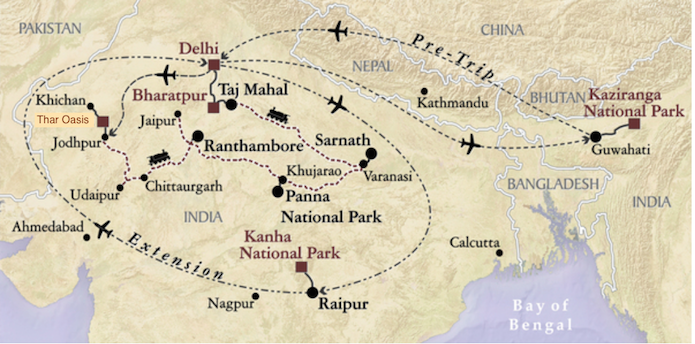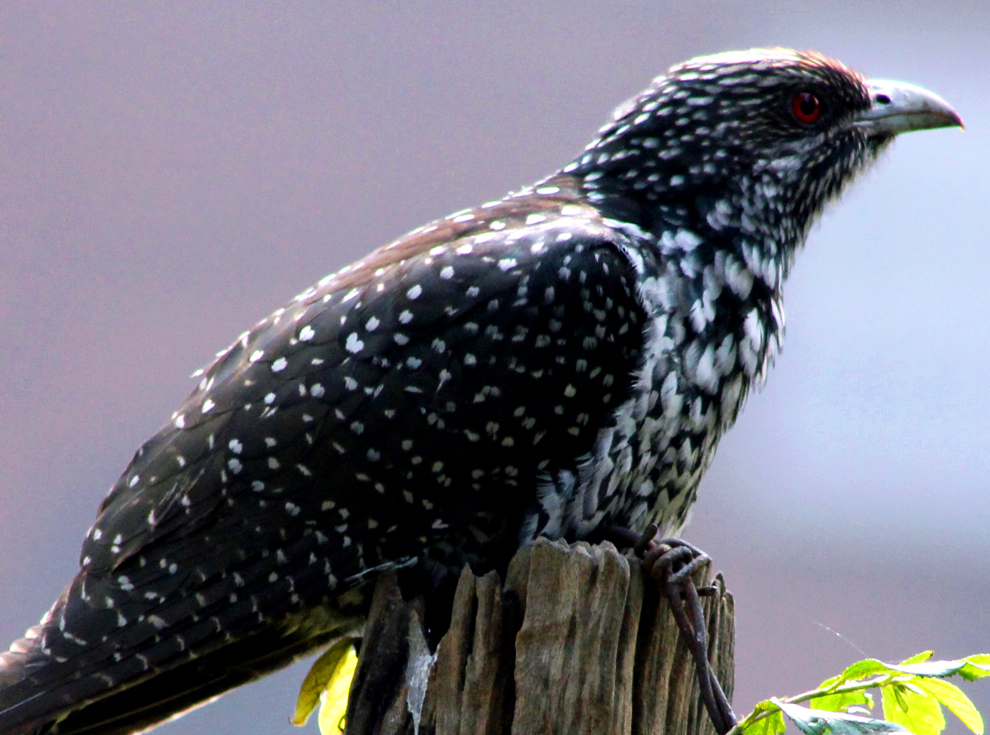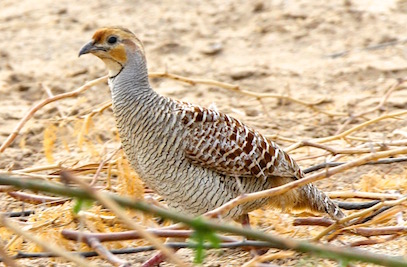
Today we flew southwest from Delhi to Jodhpur and then drove north to the Thar Oasis
(Image courtesy of VENT)
(Click on images to enlarge)

We were off in a bus to the Delhi airport by 8:30 this morning to allow time
for the torturous Indian airport rituals. I am tempted to use Vikram
Chandra’s line:
He was always a stickler for the letter of the law, and the spirit be damned. This is why a visit to any babu’s office in this land is like a little taste of death. But it truly wasn’t that bad. One wrinkle I hadn’t quite understood was that one must make sure that the little paper tags attached to each of one’s carry-ons at check-in gets stamped by the people at the scanners. Fortunately, Gajendra noticed that they had neglected to stamp one of mine and reminded them to do it, so Bad Things failed to happen later when we went through the passageway to the plane, where those tags were being inspected. I will know to watch out for this in the future. Everything went smoothly after that and we were in Jodhpur in time for lunch at the Ajit Bhawan Hotel, the former home of a maharaja. We knew we were in Rajasthan when we saw the elaborate mustachios of the doorman. And we knew we were in a maharaja’s home when we saw the very traditional garage displaying his vintage cars. |
|
Ajit Bhawan doorman and our companion Zach |
A few of the Maharaja’s cars |
| After lunch, we explored the maharaja’s gardens, which were pretty and quite extensive. They yielded us a lifebird, a pair of Asian (Common) Koels, the male plain black but the female really attractive in her white-spotted black. |
|
Ajit Bhawan gardens |
 Female Asian Koel (Image courtesy of Wikimedia Commons) |
|
We had a long drive across the magnificent
Thar Desert, a very dry
acacia woodland inhabited by impoverished but self-reliant people. As we
entered the territory of the Bishnoi, we began seeing more wildlife. The
Bishnoi are famous for their love of the plants and animals of their lands and
the lengths to which they go to protect them, even today. In 1730, they were
subjected to a terrible
massacre in which 363 of
them died literally hugging their Khejri trees, which the local lord’s
woodcutters were cutting for fuel. As we drove through their country today,
one of the larger kinds of desert tree was blooming, its flowers the color
of marigolds. A handsome euphorbia was also widespread in the desert. Now and
then in the sere grasslands, we saw Nilgai, and I finally succeeded in spotting
a pretty little Indian Gazelle (the Chinkara). They are shy
and difficult to photograph, but you can see how lovely they are in this short
video.
Our drive took us through small towns and past temples: |
|
|
|
| We passed highly decorated trucks and camels at work: |
|
|
|
|
The Thar Desert is famous for its birds. To a birder with half an hour to
spare, I recommend the video
Birds of the Indian
Thar Desert, which I have practically memorized over the past few
months.
Naturally, we stopped a few times along the way to do some birding. One good stop was near a garbage dump, where we looked up for circling raptors, mostly getting Steppe Eagles (a lifer) in several plumages and Egyptian Vultures. Another stop took us down into a wetland where we had a pair of gorgeous Red-crested Pochards and many other goodies. A particularly nasty House Crow was pursuing the shorebirds. It looked for a while as though a delicate little Stilt was not going to escape him. Later, he took out after one of the Red-wattled Lapwings, a tougher customer. I finally got to see a Grey Francolin, when two of them made their way down to the water to drink. There were many Little Grebes floating about (possibly a separate species from the European one). |
 Male Red-crested Pochard (Image courtesy of Wikimedia Commons) |
 Grey Francolin (Image courtesy of Amy Sheldon) |
|
The acacia thorns we picked up on that little stroll were murder. Back in the
bus, we struggled to pull them out of the soles of our shoes, remembering that
poor bat from yesterday.
As we continued, the roads became single lanes. When we met oncoming traffic, there was lots of honking and swerving, which all seemed to work out somehow with nobody slowing down. Once we’d turned off the main road, small children along the roadside began waving to us. There were Peafowl flying, displaying, perched in trees, sitting on fenceposts, etc., all along the way. The bus stopped for a moment so we could see a gorgeous male Variable Wheatear, splendid in black and white. We got a nice look at a male Greater Coucal who flew across the road and landed beside it. We had a few drive-past Green Bee-eaters that left me wanting a closer look (though we saw them in Jordan a decade ago). |
|
Eventually, we got onto such remote roads that adults were waving at the bus,
too. We stopped within a few kilometers of the camp just before sundown and
changed there to jeeps, as the bus could go no further.
The jeeps quickly delivered us to our tented camp, which is quite handsome and features a round reflecting pool in the middle, with large white tents (pink paisley inside) arrayed around it. We were greeted with damp cloths to wipe the dust off our faces and cold fruit drinks. I was glad they had strong young men to carry our bags to our tents, as walking through the sand was a bit of a struggle for me. I was surprised to see that our tent has a marble floor. (It also has a full bathroom; this is definitely not a camping trip.) We had half an hour in our tent to get organized before walking up to the dining tent. It was dark by then, and there were more stars visible than we’ve seen since coming to India. A tiny crescent Moon hung in the sky. The food and the conversation were pleasant, but we finished as quickly as we could, as we are expected back at the dining tent by 5:15 tomorrow morning. |
Thar Oasis Resort & Camp |
| Compulsive as I am about backing up our photos and my journal entries, there is no Internet here, so I used my Babelfish USB stick, which I must admit that I bought not because I thought I would ever need a USB stick but because it was a Babelfish. Backups done, we had no trouble getting to sleep. |

|
| My birds for the day: |
| Gadwall | Northern Pintail | Green-winged Teal | Red-crested Pochard | Grey Francolin |
| Indian Peafowl | Little Grebe | Little Cormorant | Eastern Cattle Egret | Egyptian Vulture |
| Steppe Eagle | Black Kite | Black-winged Stilt | Red-wattled Lapwing | Black-tailed Godwit |
| Rock Pigeon | Eurasian Collared Dove | Laughing Dove | Asian Koel | Greater Coucal |
| Little Swift | Green Bee-eater | House Crow | Grey-throated Martin | Dusky Crag Martin |
| Variable Wheatear | Common Myna |

